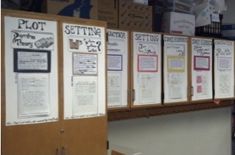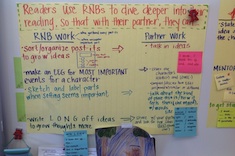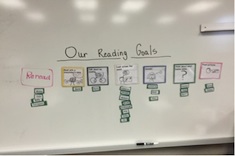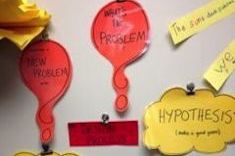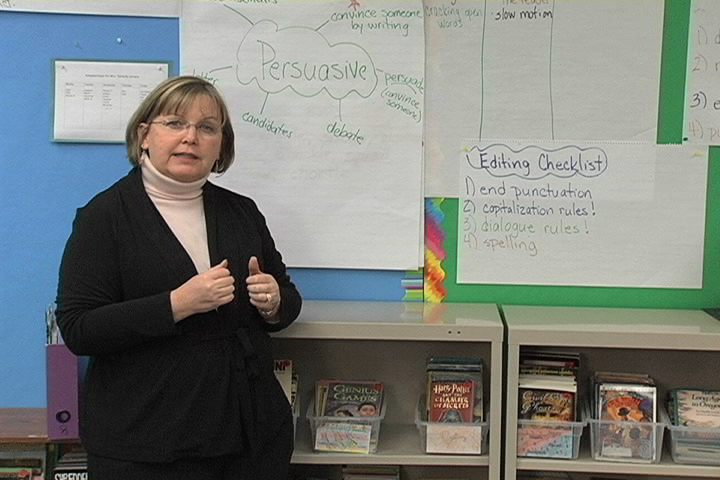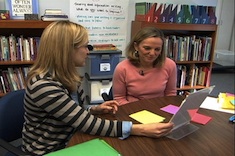“There’s a bunch of kids stuck there together.” October 9
This sentence, followed by a date, was a typical entry recorded by my students in their reader response journals. This pattern of vague generic responses was a problem in reading workshop. The first issue was that students were not displaying the ability to be reflective about basic story elements. The second issue was that there was no evidence that students could relate to the text. I would refer to this nondescript entry during conferring time. I tried to sort out if the entry came from a text penned by Sachar or Korman, and whether it took place at a juvenile detention camp in Texas or a deserted island somewhere in the Pacific.
I began thinking about how to elicit more excitement from my students when recording their thinking while reading. This increased excitement would optimistically translate into students increasing effort, creativity, and depth in their recorded thoughts. The goal was set, and now I had to figure out how to push students’ thinking beyond previous expectations. To accomplish this I began to brainstorm ideas on what would motivate me if I was sitting at that flip-top desk.
Anchor charts for me had always been a useful tool as an activator, wrap-up, and anything in between. The problem I had always seen in anchor chart design is that the charts eventually become wallpaper in a classroom. They remain on the wall, and without consistent review, become forgettable. I came up with four A’s that I would apply to anchor chart design. If my anchor charts were going to be effective, they had to be aesthetically pleasing, attainable in concept, have a practical application, and produce journal entries that could be a tool for assessing student learning.
Chart Design
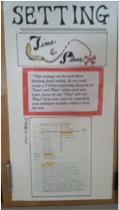 Consistency was the objective when designing my anchor charts. This would allow students to easily navigate the charts as well as influence organization of their own thoughts. The challenge for students shouldn’t be in sorting through various graphic sources plastered on the classroom walls. The challenge should be to effectively engage in applying the desired strategies.
Consistency was the objective when designing my anchor charts. This would allow students to easily navigate the charts as well as influence organization of their own thoughts. The challenge for students shouldn’t be in sorting through various graphic sources plastered on the classroom walls. The challenge should be to effectively engage in applying the desired strategies.
The top of each chart displays the story element suggested for that journal entry. The focus is a basic story element of fiction, such as character, setting, plot, or theme. This heading allows students to quickly reference which chart might help them according to their current pattern of thought. If students are reading a text that has a strong presence of character, they can efficiently scan the anchor charts focusing on character and find one that will fit their need.
Graphic
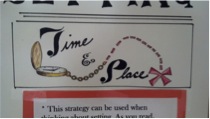 Under the focus heading is an original graphic that presents an aesthetically pleasing illustration. This is intended to draw students in and eventually create a picture for their minds when connecting a style of journal entry with a fiction story element. In the earlier anchor charts I used various fonts, but recently I have pushed myself to create more of a graphic to be associated with each story element. The source of the graphic idea comes from our work with reading specialists, my original ideas, and student concepts.
Under the focus heading is an original graphic that presents an aesthetically pleasing illustration. This is intended to draw students in and eventually create a picture for their minds when connecting a style of journal entry with a fiction story element. In the earlier anchor charts I used various fonts, but recently I have pushed myself to create more of a graphic to be associated with each story element. The source of the graphic idea comes from our work with reading specialists, my original ideas, and student concepts.
Explanation
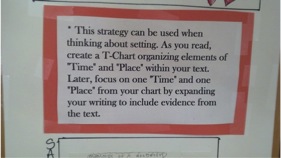 Near the center of the chart I have included an explanation of entry expectations. This explanation gives the rationale for using the strategy as well as what the result should display. Each explanation is influenced by the Massachusetts Common Core Standards in education. The definition of the entry works together with the sample entry that follows. More recent charts have key terms in bold, and have increased in length to about five to seven sentences.
Near the center of the chart I have included an explanation of entry expectations. This explanation gives the rationale for using the strategy as well as what the result should display. Each explanation is influenced by the Massachusetts Common Core Standards in education. The definition of the entry works together with the sample entry that follows. More recent charts have key terms in bold, and have increased in length to about five to seven sentences.
The chart finishes with a sample entry. I create this model entry based on a book that I have used as a read-aloud. Picture books work well for creating the sample. The sample makes the type of entry attainable to students and becomes a great reference moving forward.
The key to a successful anchor chart is to keep it relevant and practical. The chart must be relevant so that students don’t forget about its importance. It must be practical for use during various stages of literacy instruction.
Focus Lesson
When launching a new anchor chart for journal entries I always use it as the focus lesson during reading workshop. During whole-group instruction, usually in our class library, I will roll out the new anchor chart based on a text common to all students. We use the structure of the chart as a basis for discussion. This takes about 10 minutes. Students are expected to try the entry displayed on the new anchor chart that day during independent reading. The luxury of the anchor chart format is that they may refer to the chart at any time during their reading and entry scribing.
Stop and Jot
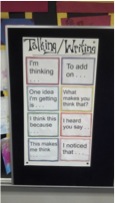 During independent reading students are expected to create a “Stop & Jot” entry in the “My Thinking” section of their reader response journal. The expectation for this entry is that students include the title of the text, the date, an original thought, and text evidence. The anchor charts are designed so that students can independently lift the level of responses to reading. Students are given the freedom to record their entry at any time during independent reading. Reminders to create an entry are given partway through this session in an effort to keep engrossed readers on pace to record their thoughts. Beyond the mandatory entry associated with the introduction of a new anchor chart, students have the freedom to choose the type of entry each day. As the number of anchor charts grows, so do the options for journal entries.
During independent reading students are expected to create a “Stop & Jot” entry in the “My Thinking” section of their reader response journal. The expectation for this entry is that students include the title of the text, the date, an original thought, and text evidence. The anchor charts are designed so that students can independently lift the level of responses to reading. Students are given the freedom to record their entry at any time during independent reading. Reminders to create an entry are given partway through this session in an effort to keep engrossed readers on pace to record their thoughts. Beyond the mandatory entry associated with the introduction of a new anchor chart, students have the freedom to choose the type of entry each day. As the number of anchor charts grows, so do the options for journal entries.
Students are not restricted to choosing an existing entry displayed on the anchor charts. They may use the Talking/Writing prompts board, which is mounted on a framed corkboard. This allows for its use to move around the classroom. It contains starters such as “I’m thinking” and “One idea I’m getting is . . .”
Students are also encouraged to create their own new type of journal entry. Many have attempted and succeeded in this task. A few are even credited as an Anchor Chart Inventor. When I see the next great anchor chart idea in a student’s journal, I work with them on how to polish their idea into the next classroom anchor chart. In a class of competitive students this goal is a perfect motivator for generating effort and excitement.
Conferring
The journal entries students create from the anchor charts may be assessed during individual and small-group conferring time. During this time, students with like entries can share aloud their recorded thinking. This leads to organic discussions about character, setting, plot, and theme. These discussions can also lead to students setting literacy objectives in the “My Goals” section of their reader response journal.
Placement
In my classroom I hang the reader response journal anchor charts on the cabinets. The cabinets in my classroom hang above and beside the student coat closet. These cabinets house various art materials, books, and extra classroom supplies. The location of these anchor charts is very valuable. When students arrive in the morning and hang their coats, they see the anchor charts. During the school day, students will retrieve various items in these cabinets, forcing them to see the charts. When students pack up during end-of-the-day homeroom, they are reminded of the anchor charts again. Visual reminders such as these, combined with verbal cues during independent reading, keep my anchor charts relevant and practical.
Six Months In
I currently have 10 anchor charts designed to help students lift the level of their responses to reading. I have a growing number of students attempting to design the next great anchor chart. An average week produces five student submissions of a new chart idea. Students are very conscious of their submissions and regularly check in to ask what I thought.
During independent reading, students are actively engaging in the anchor charts by walking over to reference them while completing a “Stop & Jot” entry. Students are also reminded of the value of the anchor charts on our daily agenda and student objectives.
The greatest achievement of the reader response anchor charts has been the increase in depth and quality of journal entries. Students are being pushed beyond previous thought to actively engage in recording their thinking, sharing their thinking, and learning from their thinking. The anchor charts have created a cyclical learning environment. The introduction of a new anchor chart doesn’t begin and end during one class. It becomes a layer in student learning. Isolation of concept cannot be a determinant in student success.

